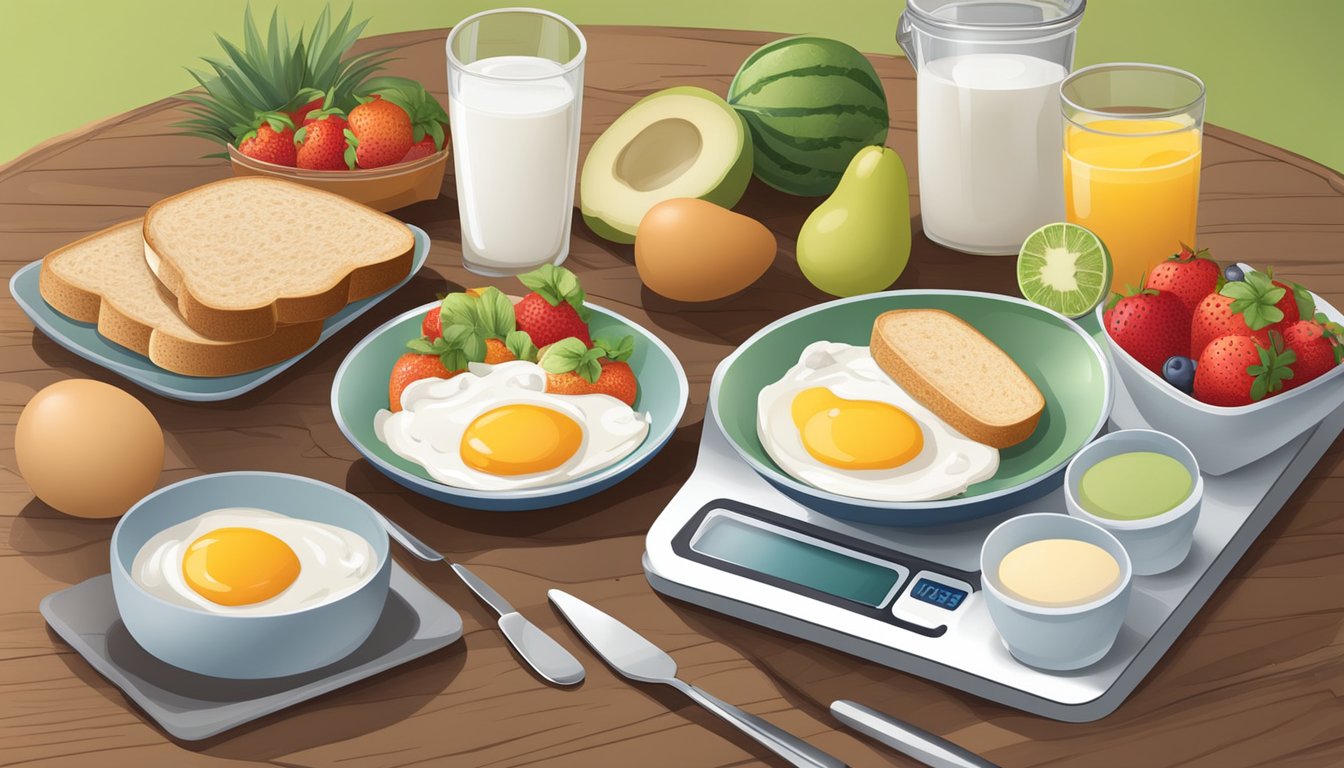Starting the day with a nutritious breakfast can set the tone for healthy eating habits and support weight loss goals. A well-balanced morning meal provides essential nutrients, boosts metabolism, and helps control appetite throughout the day.
Choosing the right breakfast foods is crucial for those looking to shed pounds while maintaining energy levels. Focusing on protein-rich options, complex carbohydrates, and healthy fats can promote satiety and reduce cravings. By incorporating nutrient-dense ingredients into breakfast recipes, individuals can create satisfying meals that align with their weight loss objectives.
1) Avocado Toast with Eggs
Avocado toast with eggs is a nutritious and satisfying breakfast option for those looking to lose weight. This simple meal combines the healthy fats from avocados with protein-rich eggs on whole grain toast.
To prepare, toast a slice of whole grain bread and top it with mashed or sliced avocado. Add a poached, fried, or scrambled egg for protein. Poached or hard-boiled eggs are the healthiest cooking methods.
This breakfast provides fiber, healthy fats, and protein, which can help keep you full and satisfied throughout the morning. The combination of nutrients may also support weight loss efforts.
For extra flavor and nutrients, consider adding toppings like sliced tomatoes, green onions, or a sprinkle of pepper. These additions are low in calories but can enhance the taste and nutritional value of the meal.
Avocado toast with eggs can be customized to fit various dietary needs. For a lower-calorie version, use egg whites instead of whole eggs. This breakfast can be prepared quickly, making it ideal for busy mornings.
2) Greek Yogurt with Berries
Greek yogurt with berries is a nutritious and delicious breakfast option for those looking to lose weight. This simple combination provides a good balance of protein, carbohydrates, and essential nutrients.
Greek yogurt is high in protein, which helps promote feelings of fullness and supports muscle maintenance. It also contains probiotics that can aid digestion and gut health.
Berries are low in calories but rich in fiber, vitamins, and antioxidants. They add natural sweetness and vibrant color to the meal without excessive sugar content.
To prepare this breakfast, start with a base of plain, non-fat Greek yogurt. Add a mix of fresh berries such as strawberries, blueberries, and raspberries on top.
For added crunch and healthy fats, consider sprinkling a small amount of chopped nuts or seeds. A drizzle of honey can provide extra sweetness if desired, but use sparingly to keep calories in check.
This breakfast is quick to prepare, making it ideal for busy mornings. It can be customized with different berry combinations or seasonal fruits to add variety to the meal.
3) Oatmeal with Almond Butter

Oatmeal with almond butter is a nutritious and satisfying breakfast option for those looking to lose weight. This combination provides a balanced mix of complex carbohydrates, protein, and healthy fats.
Almond butter adds flavor and creaminess to oatmeal while boosting its nutritional profile. It contains fiber, protein, and heart-healthy monounsaturated fats, which can help promote feelings of fullness and support weight loss efforts.
To prepare this breakfast, one can start with a half cup of old-fashioned oatmeal cooked in unsweetened almond milk. Adding a tablespoon of almond butter to the cooked oatmeal enhances its taste and nutritional value.
For additional flavor and nutrients, individuals can incorporate ingredients like cinnamon, vanilla extract, or fresh berries. These additions can make the oatmeal more enjoyable without significantly increasing its calorie content.
The protein and fiber content of this breakfast helps stabilize blood sugar levels and keeps hunger at bay, potentially reducing overall calorie intake throughout the day. This makes oatmeal with almond butter an effective choice for those pursuing weight loss goals.
4) Smoothie Bowl with Spinach

Smoothie bowls with spinach offer a nutritious and refreshing breakfast option for those seeking to lose weight. These bowls combine the convenience of a smoothie with the satisfaction of eating from a bowl.
To create a spinach smoothie bowl, blend spinach leaves with frozen banana, avocado, and unsweetened almond milk. This mixture forms a thick, creamy base packed with vitamins and minerals.
The spinach provides fiber and iron while keeping the calorie count low. Bananas add natural sweetness and potassium, while avocado contributes healthy fats for satiety.
Pour the blended mixture into a bowl and add toppings for extra nutrition and texture. Popular choices include fresh berries, sliced kiwi, and a sprinkle of chia or flax seeds.
These toppings not only enhance the visual appeal but also provide additional nutrients and antioxidants. The combination of smoothie and toppings creates a filling meal that can help control hunger throughout the morning.
Spinach smoothie bowls are customizable, allowing for variety in flavors and nutrients. They can be prepared quickly, making them an ideal choice for busy mornings.
5) Whole Grain Waffles with Peanut Butter
Whole grain waffles topped with peanut butter offer a satisfying and nutritious breakfast option for those seeking to manage their weight. This combination provides a good balance of complex carbohydrates, protein, and healthy fats.
Whole grain waffles are rich in fiber, which aids in digestion and promotes feelings of fullness. They also contain essential nutrients like B vitamins and minerals that support overall health.
Adding peanut butter to waffles increases the protein content of the meal. Protein is crucial for maintaining muscle mass and can help reduce cravings throughout the day.
The healthy fats in peanut butter contribute to satiety and may assist in weight management when consumed in moderation. A tablespoon of peanut butter typically contains about 95 calories.
For a well-rounded breakfast, consider adding sliced banana to the waffles and peanut butter. This adds natural sweetness and additional nutrients without excessive calories.
To keep the calorie count in check, opt for sugar-free syrup or a small drizzle of honey if additional sweetness is desired. Portion control is key when incorporating this breakfast into a weight loss plan.
6) Chia Seed Pudding
Chia seed pudding is a nutritious and versatile breakfast option for those looking to lose weight. This simple dish is packed with fiber, protein, and healthy fats, helping to keep you feeling full and satisfied throughout the morning.
To make chia seed pudding, simply mix chia seeds with your choice of milk and let it sit overnight in the refrigerator. The seeds absorb the liquid and develop a pudding-like consistency.
You can customize your chia pudding with various flavors and toppings. Add vanilla extract, cocoa powder, or fresh fruit for natural sweetness. Nuts, seeds, or a drizzle of honey can provide extra texture and taste.
A typical serving of chia seed pudding contains around 387 calories, with 18.3 grams of fiber and 17.3 grams of protein. This nutrient-dense profile supports weight loss efforts by promoting feelings of fullness and stabilizing blood sugar levels.
Chia seed pudding can be prepared in advance, making it an ideal option for busy mornings. Store individual portions in the refrigerator for up to four days for a grab-and-go breakfast or snack.
7) Egg White Omelette with Vegetables
Egg white omelettes are a popular choice for those seeking a low-calorie, high-protein breakfast option. By using only egg whites, the fat content is significantly reduced while maintaining a high protein content.
To create a nutritious egg white omelette, start with fresh egg whites separated from the yolks. Add a variety of chopped vegetables such as mushrooms, asparagus, peppers, or spinach for extra nutrients and flavor.
Cook the omelette in a non-stick pan with a small amount of olive oil. This helps keep the calorie count low while ensuring the omelette doesn’t stick. Tilt the pan to spread the egg whites evenly for optimal cooking.
For added taste, consider incorporating herbs or a small amount of low-fat cheese. These additions can enhance flavor without significantly increasing calories.
A typical egg white omelette with vegetables contains approximately 142 calories and 16 grams of protein, making it an excellent choice for weight management. The high protein content helps promote feelings of fullness and satisfaction.
This versatile dish can be customized to suit individual preferences. Experiment with different vegetable combinations to keep breakfast interesting and nutritious.
8) Banana and Almond Butter Wrap
A banana and almond butter wrap offers a nutritious and satisfying breakfast option for those looking to manage their weight. This simple yet effective combination provides a balance of carbohydrates, healthy fats, and protein.
To prepare this wrap, spread a thin layer of almond butter on a whole wheat tortilla. Place thinly sliced banana pieces on top of the almond butter. For added flavor, a drizzle of honey and a sprinkle of cinnamon can be included.
The banana provides natural sweetness and essential nutrients like potassium and vitamin B6. Almond butter contributes healthy monounsaturated fats and protein, which help promote feelings of fullness.
This breakfast wrap is quick to assemble and portable, making it ideal for busy mornings. The combination of complex carbohydrates from the whole wheat tortilla and the protein and fats from the almond butter can help stabilize blood sugar levels.
For those seeking to reduce sugar intake, using half a banana or substituting with berries can be effective. This versatile wrap can be customized to suit individual taste preferences and nutritional needs.
9) Protein Pancakes
Protein pancakes offer a nutritious twist on a breakfast classic. These pancakes incorporate protein-rich ingredients to create a more filling and balanced meal.
Common protein sources used in these pancakes include protein powder, Greek yogurt, cottage cheese, or egg whites. These additions boost the protein content without significantly increasing calories.
Many protein pancake recipes are lower in carbohydrates compared to traditional versions. This can be beneficial for those aiming to manage their carb intake or blood sugar levels.
Protein pancakes often contain fewer calories than regular pancakes. Some recipes provide as little as 35 calories per pancake, making them suitable for weight loss diets.
These pancakes can be customized with various toppings. Fresh fruit, sugar-free syrup, or a small amount of nut butter can add flavor without excessive calories.
For those seeking a complete breakfast, pairing protein pancakes with additional fruit or a small serving of eggs can create a well-rounded meal. This combination provides a mix of nutrients to start the day.
10) Quinoa Breakfast Bowl
Quinoa breakfast bowls offer a nutritious and satisfying start to the day. These versatile dishes combine protein-rich quinoa with a variety of toppings and flavors.
Quinoa provides a complete protein source, making it an excellent choice for those looking to lose weight. It also contains fiber, which helps promote feelings of fullness.
To prepare a basic quinoa breakfast bowl, cook the quinoa according to package instructions. Once cooked, add your choice of milk (dairy or plant-based) for creaminess.
Customize your bowl with fresh fruits like berries, sliced bananas, or diced apples. Add a sprinkle of nuts or seeds for healthy fats and extra crunch.
For a protein boost, top your quinoa bowl with a hard-boiled egg or Greek yogurt. Sweeten naturally with a drizzle of honey or maple syrup if desired.
Savory options are also popular. Try adding sautéed vegetables, avocado slices, and a poached egg for a hearty breakfast.
Quinoa breakfast bowls can be prepared in advance for convenient meal prep. Store cooked quinoa in the refrigerator and assemble with fresh toppings in the morning.
Nutritional Benefits Of A Healthy Breakfast
A healthy breakfast provides essential nutrients and energy to kickstart your day. It offers metabolic advantages and helps regulate blood sugar, setting a positive tone for the hours ahead.
Metabolism Boost
Eating a nutritious breakfast jumpstarts your metabolism after the overnight fast. This meal signals your body to begin burning calories efficiently. A protein-rich breakfast can increase thermogenesis, the process of heat production in the body. This effect may last for several hours, potentially burning an extra 150-200 calories per day.
Breakfast also replenishes glycogen stores, providing energy for physical and mental activities. Including fiber-rich foods like whole grains or fruits can promote feelings of fullness, potentially reducing overall calorie intake throughout the day.
Balancing Blood Sugar Levels
A well-balanced breakfast helps stabilize blood sugar levels, preventing drastic spikes and crashes. This stability is crucial for maintaining consistent energy and focus throughout the morning.
Complex carbohydrates, such as oatmeal or whole-grain toast, release glucose slowly into the bloodstream. Pairing these with protein sources like eggs or Greek yogurt further slows digestion and glucose absorption. This combination helps avoid sudden insulin surges and promotes steady blood sugar levels.
Balanced blood sugar contributes to improved mood, reduced cravings, and better appetite control. It may also lower the risk of developing type 2 diabetes over time.
Choosing The Right Macronutrients
Balancing macronutrients is crucial for effective weight loss at breakfast. A well-structured meal combines protein, healthy fats, and carbohydrates to support metabolism, energy levels, and satiety throughout the morning.
Role Of Protein In Weight Loss
Protein plays a vital role in weight loss breakfasts. It increases satiety, helping to curb hunger and reduce overall calorie intake. Aim for 20-30 grams of protein at breakfast.
Good protein sources include:
- Eggs
- Greek yogurt
- Cottage cheese
- Lean meats
- Plant-based options like tofu or legumes
Protein also supports muscle maintenance during weight loss. This is essential for preserving metabolic rate, as muscle tissue burns more calories than fat tissue.
Incorporating Healthy Fats
Healthy fats are an important component of a weight loss breakfast. They promote feelings of fullness and help absorb fat-soluble vitamins.
Recommended sources of healthy fats:
- Avocado
- Nuts and seeds
- Olive oil
- Nut butters
Include 1-2 servings of healthy fats in your breakfast. This could be a tablespoon of almond butter or a quarter of an avocado.
Fats slow digestion, providing sustained energy and preventing rapid blood sugar spikes. This helps maintain steady energy levels throughout the morning.
Carbohydrates And Energy Needs
Carbohydrates provide energy for morning activities. Choose complex carbohydrates that offer fiber and nutrients.
Beneficial carbohydrate options:
- Oats
- Whole grain bread
- Fresh fruits
- Vegetables
Fiber-rich carbs aid digestion and promote fullness. Aim for 20-30 grams of carbohydrates at breakfast, adjusting based on individual energy needs and weight loss goals.
Pairing carbohydrates with protein and fats creates a balanced meal. This combination stabilizes blood sugar levels, preventing energy crashes and excessive hunger later in the day.
Importance Of Portion Control
Portion control plays a crucial role in weight loss and maintaining a healthy diet. It allows you to enjoy a variety of foods while managing calorie intake effectively.
Mindful Eating Strategies
Mindful eating involves paying attention to hunger cues and savoring each bite. Use smaller plates to create the illusion of fuller portions. Eat slowly and chew thoroughly to enhance satisfaction.
Take time to appreciate the flavors, textures, and aromas of your food. This practice can help prevent overeating and promote better digestion.
Put your utensils down between bites to slow your eating pace. Avoid distractions like TV or smartphones during meals to focus on your food and body signals.
Monitoring Serving Sizes
Learn to recognize appropriate serving sizes for different food groups. Use measuring tools or visual cues to gauge portions accurately. For example, a serving of meat should be about the size of a deck of cards.
Fill half your plate with vegetables, a quarter with lean protein, and a quarter with whole grains. This balanced approach ensures proper nutrient intake without excess calories.
Pre-portion snacks and meals to avoid mindless overeating. Read nutrition labels carefully to understand serving sizes and calorie content. Keep a food diary to track portion sizes and identify areas for improvement.




